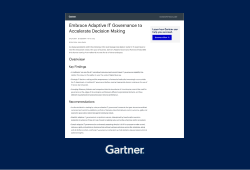Hybrid Portfolio Management - Balancing agility and Waterfall in PPM

Why is hybrid portfolio management on everyone’s lips? And why is it so difficult for so many organizations to adopt management models that simultaneously support several project management methodologies?
In today’s fast-changing business environment, companies need to be agile and flexible to remain competitive. At the same time, they must also ensure that their product and project portfolios are aligned with strategic objectives and that governance processes are strictly followed to keep elements such as risk management and financial management under control.
This is where Hybrid Portfolio Management comes in. A framework that seeks to balance agility and Waterfall to help organizations achieve their goals. In this post, we will list:
- The challenges that companies face when balancing agility and Waterfall in their project portfolio management processes.
- The essential attributes of Hybrid Portfolio Management.
- Benefits and best practices of these hybrid management approaches.
TABLE OF CONTENTS
- The challenges of balancing Agility and Waterfall in PPM Governance.
- What is Hybrid Portfolio Management? Bridging bridges between Waterfall and Agile.
- How to implement Hybrid Portfolio Management? Key elements and steps to follow.
- Hybrid Portfolio Management best practices.
- Hybrid Portfolio Management in Triskell Software.
- Conclusion: Hybrid portfolio management is a necessary step before being purely agile.
The challenges of balancing Agile and Waterfall in PPM Governance
Organizational agility is imperative today, as it is crucial to stay competitive and take advantage of existing market opportunities. However, the transition to Agile is not easy for many organizations. And it takes time, largely because of the cultural and organizational change that this transition to Agile implies for companies
For the past 20 years, many organizations have worked with a single project management methodology: Waterfall, which focuses on governance and control. We do not mean that this approach is negative. Quite the contrary, this management approach has proved to be successful in most situations. But it has some limitations in terms of its adaptability and flexibility when facing changes.

AGILE PORTFOLIO MANAGEMENT
Get the best of Agile and Waterfall
Learn more about Triskell’s capabilities for Hybrid project management.
This is why companies must move towards Agile to achieve business outcomes without losing sight of the project management methodologies that have worked so well for them over the past 20 years. And this is precisely where the great challenge lies, balancing two methodologies such as Agile and Waterfall. Agile emphasizes speed, flexibility and innovation, while Waterfall focuses on risk management, control and compliance. Finding the right balance between both is critical to successful project portfolio management.
Another challenge faced by companies adopting hybrid approaches is the optimization of their governance processes. which tend to be overly bureaucratic and tedious in most cases. These processes can have negative repercussions, such as:
- Delays in project delivery schedules.
- Loss of agility in decision-making.
- Reduced control in risk management.
- Loss of market competitiveness.
In summary, organizations must adopt Hybrid Portfolio Management to preserve their competitiveness. However, it is essential that this combination of Agile and Waterfall methodologies is done in a structured way to maximize business results.
SUBSCRIBE TO OUR NEWSLETTER
Get stories like this in your inbox
What is Hybrid Portfolio Management?
With the implementation of Hybrid Portfolio Management, organizations can strategically synchronize traditional and agile practices, thus optimizing project portfolio management and minimizing the risks associated with such a transition.
But what is hybrid portfolio management? It is a concept that involves combining the planning strategies of traditional project management methodologies with the flexible and adaptable approaches of agile methodologies.
The starting point is obvious: not all projects can be agile, and not all organizations are ready to work with agile approaches. It’s as simple as that. Just because your organization handles multiple projects per year and wants to increase its agility doesn’t mean you should manage all projects using an agile framework.
Instead, Hybrid Portfolio Management allows different approaches to be adapted and combined according to the nature and requirements of each project, thus optimizing efficiency and success. For example, there are projects for which it may be more appropriate to adopt a more traditional management approach during the planning and design phases, and use agile practices during the product development phase. Or vice versa.
WEBINAR
Hybrid Project Management: How to balance Agile and Waterfall
Hybrid Portfolio Management integrates both approaches to suit the specific needs and goals of an organization’s portfolio management process. That´s because Hybrid Project Management methodologies recognize that different projects may have varying requirements, complexities and constraints. Therefore, organizations can tailor their PPM processes and apply different methodologies or techniques at different stages of the portfolio management lifecycle or for specific projects within the portfolio.
The ability to integrate both approaches will result in a marked improvement in portfolio performance, allowing you to tailor the management methodology to the specific needs of each project, thus optimizing efficiency and successful delivery of results.
Benefits of Hybrid Portfolio Management
By adopting hybrid portfolio management, organizations can benefit from the advantages of combining the best of traditional and agile approaches to project portfolio management. This strategic combination will allow you to achieve higher efficiency, flexibility, and adaptability, thus optimizing the overall performance of your projects.
Below, we will explore in more detail the key benefits of Hybrid Portfolio Management, and how this approach can drive success in delivering projects in dynamic and changing environments.
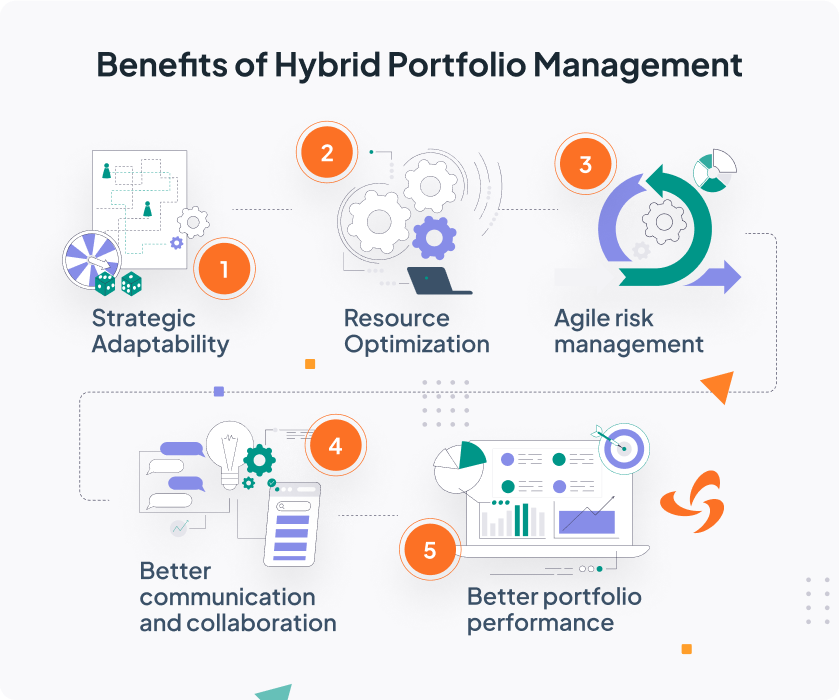
- Strategic adaptability: thanks to Hybrid Project Portfolio Management, you will be able to adapt the management methodology to the needs and strategic objectives of each project or program you manage. This will improve your responsiveness to unforeseen changes, and your project portfolios will be permanently aligned with strategic objectives.
- Resource optimization: depending on the management approach used for each project, you will maximize resource usage and ensure that resources are efficiently allocated to the projects with the highest strategic value. You will thus minimize resource constraints and bottlenecks and optimize the overall performance of your project portfolios.
- Agile risk management: Hybrid Portfolio Management integrates agile approaches to proactive risk management. By combining practices such as early risk identification, continuous adaptation and ongoing monitoring, you will achieve more effective portfolio risk management. This allows quick and efficient mitigation of potential risks, thus reducing the likelihood of negative impacts on projects and the overall portfolios.
- Strategic communication and collaboration: you will improve communication and collaboration between all teams, stakeholders and sponsors involved in project portfolios. By fostering transparency, strategic alignment and active stakeholder participation, better strategic decision-making, increased engagement and more efficient execution of portfolio projects are achieved.
- Improved portfolio performance: with Hybrid Project Portfolio Management you will optimize the performance of your product and project portfolios by applying feedback and retrospective processes. By leveraging the benefits of agile approaches, you improve the efficiency, quality and continuous delivery of value in your portfolios, which will result in a higher success rate in achieving strategic objectives and a sustainable improvement in overall portfolio performance.
See how to leverage your hybrid approach with Triskell
Request a demo and see how you can gain flexibility for rapid iteration, maintain control over project lifecycles, and ensure your projects deliver value.
How to implement Hybrid Portfolio Management? Key elements and steps to follow
You know the benefits, but how do you get there? What are the steps to take to implement Hybrid Portfolio Management? It is not an overnight process. On the contrary: it is a continuous improvement process that requires a combination of top-down and bottom-up management approaches for its successful implementation.
Here are the 5 steps that organizations should follow to implement Hybrid Project Portfolio Management:
1. Establish a governance framework
Embracing hybrid portfolio management will involve redefining many of your management and governance processes. You will need to evaluate and redefine your governance framework and establish new policies, procedures and standards for the hybrid management of your Product and Project Portfolios.
This is a necessary step to also restructure decision-making processes, resource allocation or financial management, and to align projects and programs with strategic objectives while executing them effectively.
2. Assess the current state of your PPM processes
Next, you should assess the current state of your PPM processes. This includes reviewing the methodologies, tools and resources currently in use. This step is important as it will help you to identify the strengths and weaknesses of your organization and the areas for improvement in your current PPM processes.
WHITE PAPER
Interfacing between Linear Waterfall and Agile Approaches
3. List all projects and programs
Now, you should list all the projects and programs that make up each of the organization’s portfolios, and evaluate which ones are more suitable for agile methodologies or which ones can continue to be managed with Waterfall.
This assessment must be made based on several factors such as project complexity and objectives, stakeholder expectations and the dynamics of the teams to be involved. For example, while agile methodologies work best on dynamic and innovative projects, Waterfall is better suited to projects with well-defined requirements.
4. Define rules
As part of PPM Governance, you need to establish rules to define which projects can be worked with Agile or Waterfall. Depending on factors such as risks, project complexity, scale or available resources, some projects and programs have to be managed following purely Agile approaches. Or, for some others, follow hybrid management approaches, incorporating elements of Agile into your traditional project management processes.
This also implies defining how the different methodologies will be applied at various stages of the portfolio management lifecycle, such as project initiation, planning, execution, monitoring, and control. You must design a governance structure that supports the hybrid approach.
5. Continuous assessment
You should regularly evaluate and refine the KPIs of each portfolio after analyzing the performance of Agile and Waterfall projects. Use this assessment to identify trends, patterns, strengths, and areas for improvement of each approach, and share these insights across the organization to foster learning and improve business performance.
By measuring and consolidating KPIs from Agile and Waterfall approaches, you can gain a comprehensive view of your portfolio’s performance and make informed decisions to improve project portfolio performance.
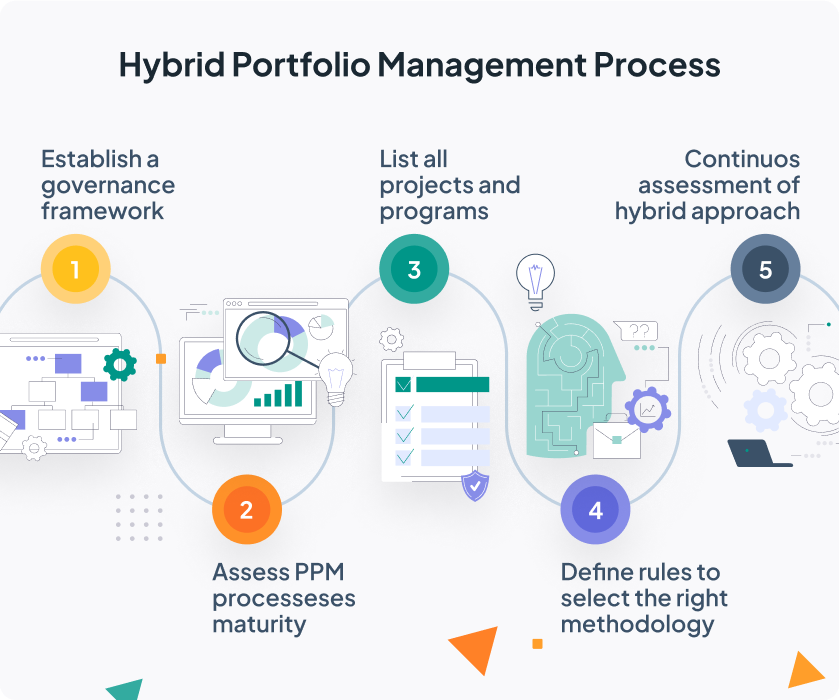
Learn from past projects and experiences to identify areas for improvement and apply best practices
Key elements of hybrid portfolios
Once you have followed these steps to implement Hybrid Portfolio Management, it is important to understand the key components of this approach. These elements provide the foundations for a balanced and effective approach to hybrid portfolio management, allowing organizations to take advantage of the best of both worlds: the flexibility and adaptability of Agile and the structure and predictability of traditional approaches.
Now let’s look at the key elements of Hybrid Portfolio Management:
1. Flexibility
This is a key element for the successful implementation of Hybrid Portfolio Management, as it is what allows organizations to be responsive to changing circumstances and requirements. Iterative planning, continuous value delivery or actively involving stakeholders are some of the practices you should put in place to make your organization more responsive.
2. Continuous improvement
Efficient hybrid portfolio management is not possible without continuous improvement processes. Continuous improvement will provide you with mechanisms to evaluate the performance of Agile and Waterfall methodologies in different projects and programs, as well as to identify problems and opportunities for improvement in advance. You will create a feedback loop thanks to which you will improve project selection, methodological decisions, resource management or risk management.
3. Waterfall
While flexibility is a key element of hybrid approaches, it requires traditional project management practices such as detailed planning, risk management or change management. This will ensure effective resource management and on-time, on-budget project execution in a hybrid portfolio management approach.
4. Agile practices
Finally, the incorporation of agile methodologies such as Lean, Scrum or DevOps are a key element of Hybrid Portfolio Management. They help organizations gain adaptability to possible changes and to speed up delivery times without compromising the performance of their portfolios.
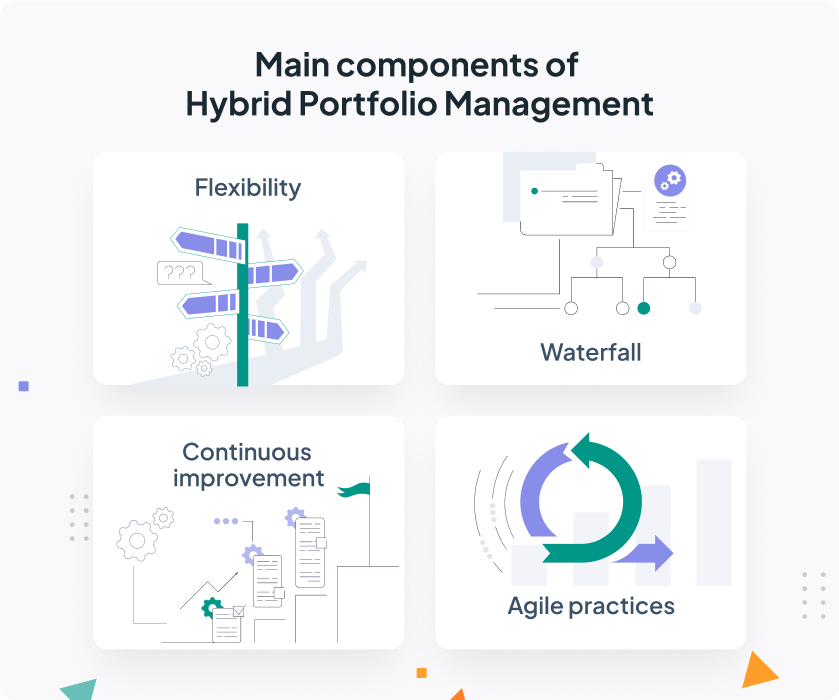
Hybrid Portfolio Management best practices
Successful implementation of hybrid project portfolio management requires a strategic approach and the adoption of sound best practices. In this regard, the following are seven key best practices for the effective implementation of hybrid project portfolio management.
These practices will enable organizations to leverage the benefits of combining traditional and agile approaches, optimizing resource allocation, fostering communication and collaboration, and promoting continuous improvement in project execution within the portfolio.
- Define a strategy: establish a clear strategy that defines both the project selection and prioritization criteria and the management approaches to be used. This will ensure effective alignment between project portfolios and strategic objectives.
- Establish a framework that supports different management methodologies: create a hybrid framework that combines the best practices of different approaches (such as PMI, Scrum, Kanban, etc.) and that adjusts to the needs and characteristics of each portfolio. This will enable consistent and efficient management of all of them.
- Flexibility in resource allocation: Ensure that resources are allocated in an optimal and flexible manner, taking into account both the needs of each project and the capacity of available resources. This will maximize resource utilization and minimize resource constraints.
WEBINAR
How to manage resource constraints in a multi-portfolio environment
- Foster learning and continuous improvement: Establish a feedback and learning process that allows the capture of lessons learned and the implementation of improvements for hybrid portfolio management. This will create a culture based on continuous improvement where lessons learned are valued and leveraged to optimize the execution of future projects.
- Create a solid governance framework: Implement a robust governance system that includes clearly defined roles and responsibilities, efficient decision-making mechanisms and a proactive approach to risk and problem management. This will ensure effective strategic direction and adequate control over portfolio management.
- Encourage communication and collaboration: promote communication through the use of tools and techniques that foster transparency, knowledge sharing and participatory decision-making.
- Implement a PPM software that allows pivoting between different management approaches: having a PPM software that allows adapting the management methodology according to the needs and context of each project portfolio is critical to obtain the flexibility and responsiveness that we have discussed throughout the post.
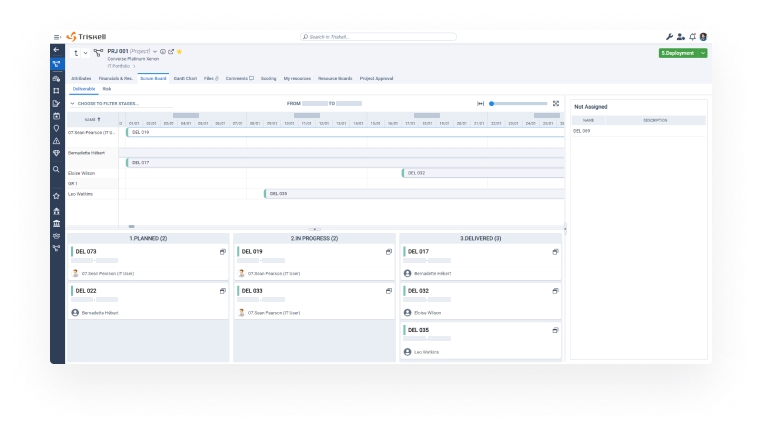
Embracing Hybrid Portfolio Management with Triskell
Therefore, having a PPM software such as Triskell Software becomes a key element to achieve a successful implementation of Hybrid Portfolio Management. Triskell offers total flexibility to pivot between different management methods, allowing organizations to adapt the methodology according to the needs and specific context of each project portfolio.
Its comprehensive approach and advanced capabilities provide teams with the responsiveness needed to effectively manage both agile and traditional projects and programs, providing a unified and transparent view of portfolios as a whole.
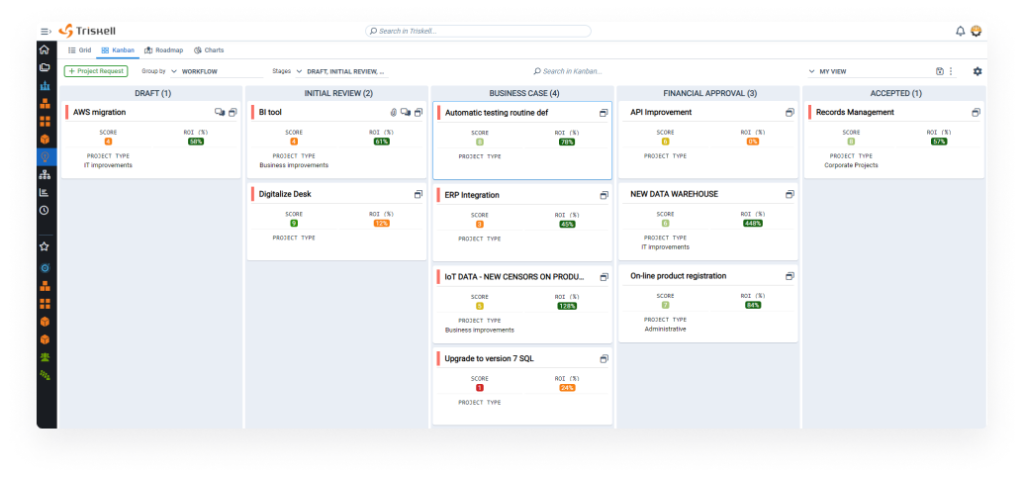
These are some of the functionalities that Triskell includes for Hybrid Portfolio Management:
- Planning tools: Triskell offers features to plan any object (projects, programs, portfolios, etc) for different approaches, such as Gantt charts for Waterfall and Kanban boards for Agile.
- Scoring models: Triskell’s scoring models provide you with an objective framework for evaluating incoming projects and demands. They will help you establish a standardized methodology for assessing various factors, such as financial viability, strategic alignment, risk profile and resource requirements, from which you can determine the appropriate project management methodology for each case.
- Capacity planning: with Triskell you can efficiently manage your organization’s resources and capacity, including staff allocation, workload tracking or medium and long-term capacity planning.
- What-if scenario analysis: Thanks to Triskell’s what-if scenario analysis feature, you can now assess in advance the consequences for your project portfolios of other elements that you may not have been able to contemplate before, such as resource constraints, budget adjustments or priority changes.
- Integrations with 3rd party tools: thanks to Triskell’s API you will be able to integrate in a single interface all the tools you use to manage your project portfolio. Integrating PPM software with applications such as Jira, SAP, Teams or Microsoft Project is easier than ever with Triskell.
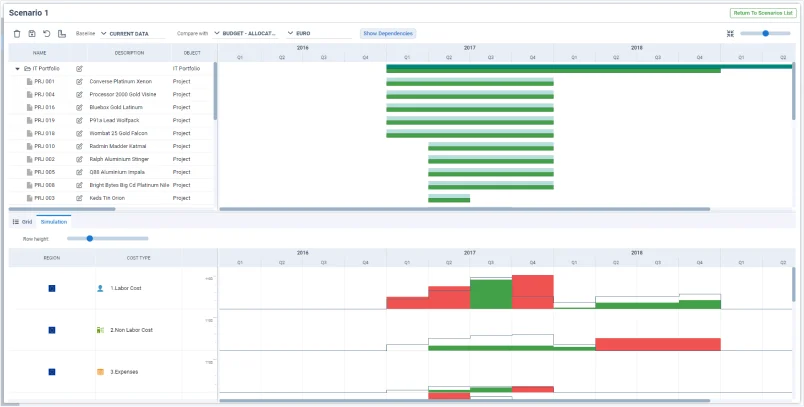
Conclusion: Hybrid portfolio management is a necessary step before being purely agile
In summary, hybrid portfolio management is an effective solution to address the challenges of balancing agility and governance in project and program management. By combining traditional Waterfall approaches with agile methods, organizations can leverage the best of both worlds and adapt to an ever-changing business environment. Successful implementation of hybrid portfolio management requires a combination of key elements, such as defining clear roles and responsibilities, collaboration across teams, and the use of appropriate tools.
In addition, it is essential to follow best practices to maximize the benefits of hybrid portfolio management. This involves establishing a culture of continuous learning, fostering open and transparent communication, and adapting processes as needed. Triskell, the most flexible PPM tool, provides the perfect support for implementing hybrid portfolio management in your organization, offering a PPM platform that enables organizations to effectively implement and optimize their project and program management strategies.
SUBSCRIBE TO OUR NEWSLETTER
Get stories like this in your inbox
Request a demo of Triskell Software
Want to learn more? Request a free demo of Triskell Software and you will discover the PPM software that best suits your business needs.
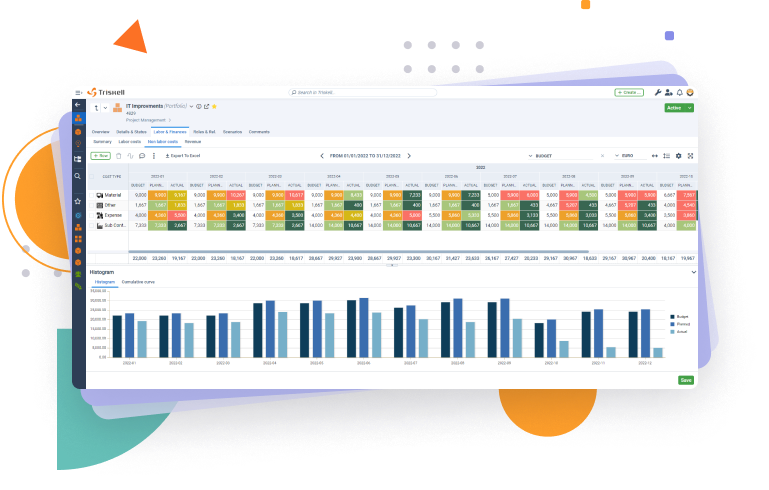
FAQs about Hybrid portfolios
Why should you consider a hybrid portfolio management approach?
There are several advantages to using hybrid portfolios:
- Increased adaptability: Respond effectively to changing market demands and project requirements.
- Improved resource allocation: Allocate resources based on project needs, balancing agility with control.
- Enhanced project success rates: Leverage the strengths of both traditional and Agile approaches to increase project success.
- Greater team satisfaction: Agile practices can foster team collaboration, ownership, and motivation.
When is a hybrid portfolio management approach appropriate?
A hybrid approach can be beneficial for organizations that manage a diverse portfolio of projects with varying levels of complexity and requirements. Here are some indicators:
- The need for both control and flexibility: Balance the need for clear structure with the ability to adapt to changing circumstances.
- A mix of project types: Manage a combination of well-defined projects and those with evolving requirements.
- Desire for faster time-to-market: Deliver value quickly while maintaining control over critical aspects.
How can I implement a hybrid portfolio management approach?
Here are some initial steps to implement a hybrid portfolio:
- Assess your current project portfolio: Identify the types of projects you manage and their suitability for traditional or Agile approaches.
- Define clear roles and responsibilities: Assign ownership for different project management methodologies within the hybrid framework.
- Invest in the right tools and technologies: Consider PPM software that supports both traditional and Agile project management practices.
- Train your team: Equip your team with the skills and knowledge to work effectively within a hybrid environment.

